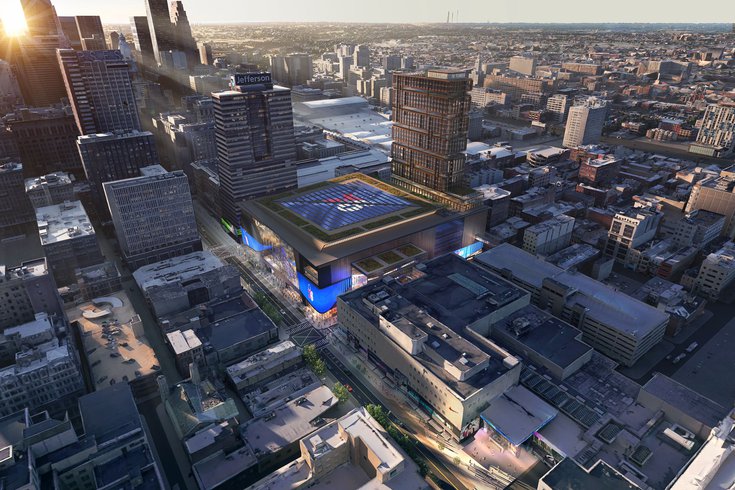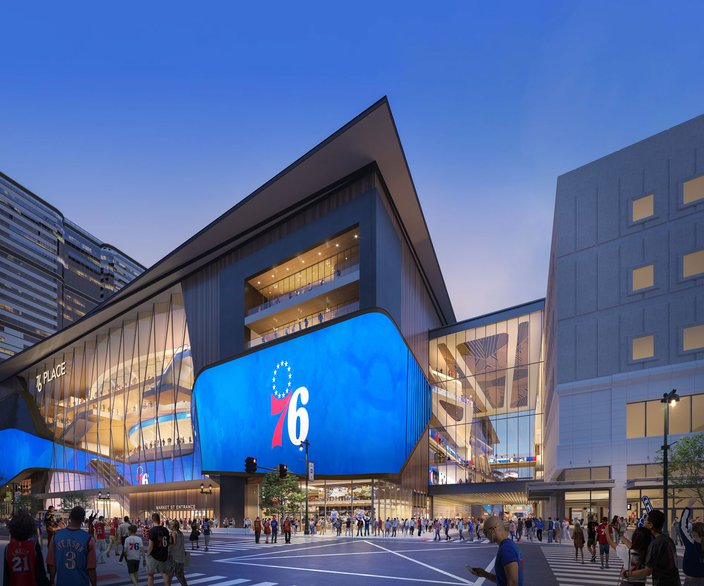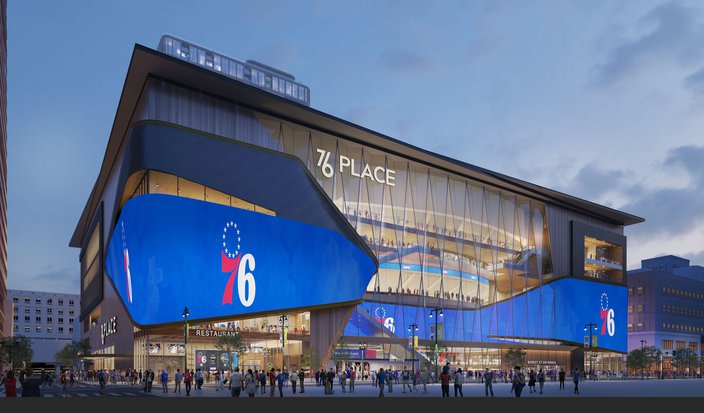
August 09, 2023
 Provided Image/Gensler
Provided Image/Gensler
The Philadelphia 76ers have proposed adding a residential tower with 395 units to the team's planned arena on East Market Street in Center City. The team says it would include affordable housing units.
The 76ers' arena proposal now includes a residential tower with affordable housing units and a public promenade that runs beneath the 18,500-seat facility.
New renderings of the East Market Street arena, unveiled Wednesday, show the 20-story tower rising above the former Greyhound bus station at the north end of the arena site. Team officials said the tower would include 395 units, with 20% of the apartments designated as affordable housing.
Adding the tower will add $250 million to the arena's $1.3 billion price tag. The Sixers would aim to build the two projects simultaneously, team spokesperson Nicole Gainer said. The team has pledged to privately finance the arena, which would occupy a portion of the Fashion District Philadelphia mall between 10th and 11th streets, and Market and Cuthbert streets.
City officials confirmed that the proposed residential tower is being considered in the three studies evaluating the arena's potential economic, design and community impacts. The team said the tower plan was submitted in reports and other analyses provided to the city.
At mixed-income housing projects, rents for affordable units are calculated based on a percentage of the area median income where they're located. The term "affordable housing" varies but generally is defined using AMIs that are set geographically each year by the U.S. Department of Housing & Urban Development.
The federal government divides affordable housing into three tiers. Low-income households earn less than 80% of the AMI. Very low-income households earn less than 50% of the AMI and extremely low-income households earn less than 30% of the AMI.
The 76ers have not decided which income ranges would be used to calculate rents for the tower's affordable units, Gainer said.
The team emphasized that the site where the arena is proposed in Philadelphia's First District is not zoned to require affordable units, as is now the case for residential projects in parts of the city's Third and Seventh districts.
This rendering shows an aerial view of the 76ers' proposed arena and residential tower on East Market Street between 10th and 11th streets.
In most of Philadelphia, developers are given the option to include affordable homes in their projects in exchange for adding more floors and market-rate units. If affordable units aren't included in an expanded project, the developer can pay into a fund that supports affordable housing elsewhere in the city. The Mixed-Income Housing Zoning Bonus program allows developers to include affordable units at a moderate or low-income level, with a greater density bonus given to projects that include low-income units.
Gainer said the 76ers want to address community concerns about the arena driving up housing costs while also creating more residential foot traffic along East Market Street. The team will not need to pursue a zoning bonus because the tower's proposed site is already zoned to allow for maximum density in the core of Center City, she said.
The proposed residential tower was met with criticism by the opponents of the arena plan.
"We can't trust the claims of these developers, who have built their careers and fortunes on displacement and helped create the housing crisis," said Neeta Patel, interim executive director of Asian Americans United, which is part of the Chinatown coalition opposed to the new Sixers arena.
Patel pointed to 76ers part-owner David Adelman's role as CEO of Campus Apartments, the student housing company that was started in West Philadelphia and has since grown to become one of the largest companies of its kind in the United States.
"Adelman makes his money gouging college students on rent in what used to be the Black Bottom, where Black families were pushed out to make way for University City," Patel said.
Patel likewise criticized the team's majority owners at Harris Blitzer Sports & Entertainment, which also owns the New Jersey Devils and Washington Commanders, among other pro sports teams. Josh Harris' former private equity firm, Apollo Global Management, played a key role in providing funding that led to the closure of Hahnemann Hospital, Patel said. And David Blitzer holds a high-ranking position at Blackstone Inc., the global investment management company that drew rebuke from the United Nations several years ago over claims that its business practices had fueled a global housing crisis.
Other critics of the 76ers' arena proposal said the team's track record in Camden, where it built a practice facility in 2016, shows the team failed to follow through on promised jobs and other benefits to the community.
"These very same developers who own 76DevCorp have made fortunes by gentrifying neighborhoods and making housing less affordable, throughout the city and around the world," said Rev. Michael Caine, pastor of Old First Reformed UCC in Old City and co-chair of POWER Interfaith's Board of Directors.
A rendering of the 76ers' proposed new arena shows the public promenade that would be created by elevating the arena's event floor.
The Sixers' revised arena design also raises the event floor one story above street level, creating a public promenade that flows between Market Street and Cuthbert Street at the southern border of Chinatown.
The new floor design came in response to concerns about the arena's potential impact on Jefferson Station. Earlier designs had the arena floor at or below ground level, prompting questions about whether the building's construction would compromise the train station below.
The 76ers' arena proposal relies heavily on the expectation that fans will use public transportation to attend games and other events. Raising the arena floor above street level will enable the creation of a new Market Street entrance to Jefferson Station, one of the region's busiest transit hubs, the team said.
Only about 15% of 76ers fans currently use public transit to attend games at the Wells Fargo Center in South Philadelphia. The team believes an East Market Street arena would boost that number to nearly 50%. Fans who drive to Center City would use one of 29 parking garages that contain 9,000 spaces within walking distance of the arena, according to team projections shared in May.
Raising the event floor also would increase opportunities for street level retail at the arena site, the team said.
Another rendering of the 76ers proposed new arena on East Market Street.
In May, 76ers part-owner David Adelman said the team had been considering adding a residential component to the arena proposal. The team also has promised a $50 million community benefits agreement with Chinatown that the 76ers say will be tailored to address many of the community's concerns about the project.
In the year since the 76ers proposed their Center City arena, most of the team's community engagement has been conducted in small groups with stakeholders in Chinatown. Team officials have said they plan to hold more community events to present their plans in the near future, but have not released any further details.
The 76ers want to gain city approval for the arena by the end of this year. The team's goal is to begin demolition work on the mall in 2026 and to construct the new arena in time for the 76ers to play there in 2031, when their current lease expires at the Wells Fargo Center.
 Provided Image/Gensler
Provided Image/Gensler Provided Image/Gensler
Provided Image/Gensler Provided Image/Gensler
Provided Image/Gensler